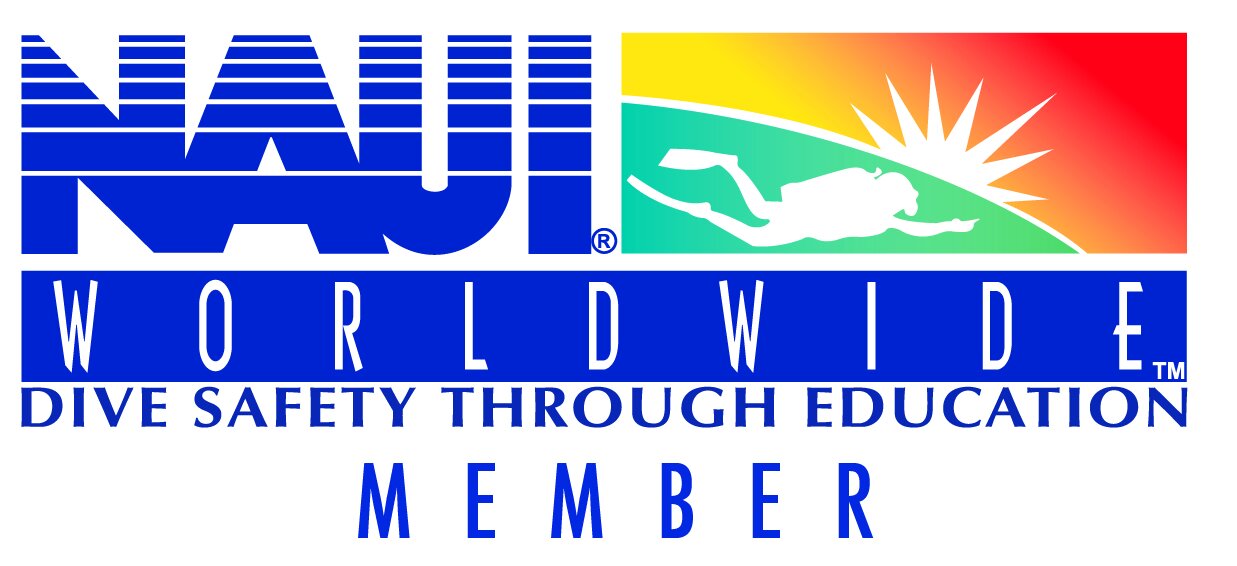
Learn to Dive
Become certified to SCUBA Dive with a NAUI certification
OVERVIEW AND QUALIFICATIONS
This is a certification course for certified scuba divers who desire to assume greater rescue capabilities during diving activities. The training emphasizes accident supervision and management with practical applications in open water. This course is designed specifically to provide the knowledge and skills necessary to:
Help prevent diving accidents.
Recognize life-threatening diving situations.
Correctly initiate and/or supervise rescue/assist procedures.
Effectively perform in-water rescue/assist techniques and procedures.
Correctly manage rescue assistants during and after rescues.
Provide immediate, effective post-rescue aid.
Correctly manage a diving emergency with adjustments for local variants. Graduates are considered competent to perform assists and rescues in aquatic situations so long as the situation approximates one for which they have been trained.
Prerequisites
Age. Minimum is 17 years by the water phase of the course.
Certification/Experience/Knowledge. Certification as a NAUI Advanced Open Water Scuba Diver or the equivalent is required. The instructor is to ensure adequate student knowledge and capability before any open water training and shall use skill or other evaluations to do so. One open water dive (which does not count toward the minimum number of dives required for the course) may be used as a screening and evaluation dive. This is not required when the student’s diving proficiencies are well known to the instructor.
Equipment. Students shall furnish and be responsible for the care and maintenance of their own diving equipment. The instructor shall initially assist the student in checking all student gear to ensure it is adequate and in proper working order.
Course Description (minimum of 4 academic hours and a minimum of 1 open water dive which includes one or more skin or scuba rescue exercises)
REQUIREMENTS – ACADEMIC
Diving Safety
If first aid and CPR certification are not offered as part of the course <they are not>, current certification in both is required for certification.
Training shall include: one rescuer adult CPR, infant/child CPR, two rescuer CPR, and rescue mask-barrier device use. (Certification as a swimming instructor and in lifeguarding is strongly recommended.)
Proof of oxygen administration training within the past two years is required unless oxygen administration is offered as part of the course <it is not>. Oxygen administration training must include the assembly, use, and basic maintenance of constant flow and demand-valve oxygen delivery systems.
Accident prevention factors for physical condition, mental condition, skill proficiency, equipment, environment, problem anticipation and training.
Diving first aid: causes, signs, symptoms, first aid procedures and prevention of stress and panic, near-drowning, decompression sickness, lung overexpansion injuries, cramps, hyperthermia and hypothermia, shallow water blackout, seasickness, local aquatic life-inflicted injuries, sprains and fractures, burns (including sunburn), severe bleeding and shock.
Diving rescue techniques for self-rescue, diver assists, surface and underwater rescues, transport, in-water rescue breathing, boat and shore exit techniques.
First aid and CPR skill review for primary survey of victim (survey of scene, danger assessment, victim response, airway, breathing and circulation) and secondary survey of victim, respiratory arrest and blocked airway management including rescue breathing, cardiac arrest including both one and two rescuer CPR, control of bleeding, bandaging and splinting and transport of victims including those with suspected spinal injuries.
Diving first aid kits and oxygen delivery systems including administration skills.
Recompression therapy including theory and goals.
Accident management and emergency procedures for creating site-specific accident management plans including emergency duties and delegation of duties, missing diver procedures, omitted decompression procedures and various diving accident procedures, access to emergency transport/ assistance including contact with Divers Alert Network (DAN) and/or alternative service and access to hyperbaric facilities, accident information documentation procedures including victim information collection and transfer, accident reporting procedures, procedures for securing victim’s equipment, liability and legal considerations and victim evacuation procedures (land, sea and air).
REQUIREMENTS – SKILLS
Emergency/Rescue/Problem Solving.
On the surface, identify the problem and properly assist a completely equipped skin or scuba diver simulating each of the following: a muscle cramp, rapid shallow breathing, exhaustion, signs of pre-panic and breathing difficulties (due to suit constriction, cold water, etc.).
Scuba Diver Rescue.
With the aid of one assistant, remove a diver simulating a non-breathing unconsciousness victim from the water after reaching the water’s edge, boat or platform.
SOS-ER Requirements
The class sessions (in addition to eLearning) will consist of
If a student has not taken the NAUI Rescue Diver course prior to this one, 1 or more confined water sessions may be required. This sessions do not count towards the required open water dives in order to obtain certification.
1 open water dive (which does not count toward the minimum number of dives required for the course) will be used as a screening and evaluation dive. This is not required when the student’s diving proficiencies are well known to the instructor..
A Minimum of 6 open water dives with the instructors.
The maximum depth for any open water dive during this course is 40m (130 ft). No dives are to require actual staged decompression.
SOS-ER Provided Gear
We can provide buoyancy compensator (BC), regulator sets, cylinders (tanks), and air fills for the course. (See first bullet in “Students must provide their own” if you are a in a dive profession)
Students must provide their own:
Any diver taking this course working as a PSD or professional dive career is required to provide their own equipment since that is what you will be using on the job.
Mask, snorkels, fins, dive boots, weight belts, and soft weights (we will assist in where to obtain this gear).
Wetsuit or any other rental gear.
Open water Checkout Dive options:
Local Quarry check out dive fees (usually a daily fee per diver) are not included in the cost of the course.
Open water checkout dive trip to Florida is not included. These cost will vary by season, locations in Florida, economy, and personal preferences of the student.



